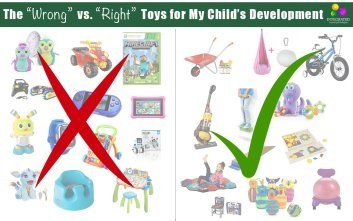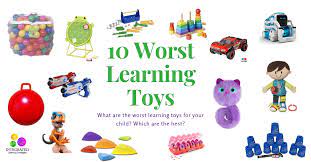When I was twenty-two years old, I wanted two things: 1. To be understood. 2. For people to think I was good at my job....Read more
Toys, regularly regarded as mere objects of play, wield a splendid impact on the multifaceted increase of an infant. From the earliest degrees of infancy through the critical youth of childhood, those playthings interact with a child’s growing mind and body, fostering critical aspects of their cognitive, emotional, social, and bodily improvement.
The synergy between youngsters and their toys engenders surroundings of exploration, creativity, and mastering, in which the seeds of imagination are sown, problem-solving skills take root, and emotional intelligence blossoms.

In this exploration of the profound impact of toys on an infant’s growth, we will navigate thru the numerous ways in which those important play partners form a toddler’s man or woman, nurturing the building blocks for a lifetime of learning and development. Through this journey, we will uncover how toys, in their simplicity, emerge as powerful catalysts for the holistic growth of an infant.
I believe you intended to ask about how toys affect the growth of children. Here’s a table of contents for a comprehensive discussion on the topic:
Definition of toy and play
Toys and Play:
Toys are objects in particular designed for entertainment and amusement, supposed to engage individuals in playful activities. They embody a numerous array of objects, starting from conventional bodily toys which include dolls, motion figures, and constructing blocks, to fashionable digital devices and interactive video games.
Play, then again, is a voluntary, self-directed, and intrinsically prompted interest engaged or entertainment and activity. It is a prevalent and vital factor of early life, serving as a car for getting to know, socialization, and the development of various abilities Play is characterized by its spontaneity, flexibility, and ability to stimulate a child’s creativeness, creativity, and hassle-fixing abilities.
It occurs throughout different forms, which include fake play, positive play, bodily play, and video games, every contributing uniquely to a baby’s holistic boom and properly-being. Through toys and play, youngsters discover they are international, build meaningful connections with others, and accumulate essential existence abilities that lay the foundation for their future improvement.
Importance of Childhood Growth and Development
Childhood boom and improvement play a pivotal position in shaping the trajectory a an man or woman’s existence. This critical duration, marked with the aid of fast physical, cognitive, emotional, and social ameliorations, sets the foundation for future learning, fitness, and properly-being.
During this time, the brain sin famous heightened plasticity, making it in particular receptive to studying and environment effects. It is within this context that the significance of supplying a nurturing and stimulating environment for youngsters becomes obvious, as it directly impacts their long-term effects.
The Role of play in child Development
Play is a fundamental component of early life that encompasses numerous paperwork, each contributing uniquely to a baby’s holistic boom and improvement. Through play, kids have interaction in sports that stimulate their creativeness, creativity, hassle-solving abilities, and social interactions. Let’s explore a number of the one-of-a-kind styles of play and their particular affects on a baby’s increase:
1. Pretend Play (Imaginative Play)
Pretend play involves kids the use of their creativeness to create fictional scenarios and act out roles. Whether they become medical doctors, firefighters, or superheroes, this form of play fosters creativity, abstract questioning, and emotional expertise. By exploring special roles and perspectives, youngsters broaden empathy and benefit insights into the arena around them.
2. Constructive Play
Constructive play centers on constructing and growing the usage of diverse substances like constructing blocks, puzzles, or art resources. This type of play enhances first-class motor abilities, spatial recognition, and problem-fixing skills. Children study to plan, prepare, and execute their thoughts, fostering a sense of feat and self belief.
3. Physical Play
Physical play entails sports that get children transferring and active, along with strolling, leaping, mountain climbing, and playing sports activities. This kind of play promotes physical fitness, motor development, and coordination. Additionally, bodily play affords an outlet for liberating energy, lowering strain, and improving basic well-being.
4. Social Play
Social play encompasses interactions with friends and adults, permitting kids to expand essential social capabilities, consisting of conversation, cooperation, and war resolution. This form of play complements emotional intelligence and lays the foundation for wholesome relationships later in existence.
5. Games with Rules
Games with regulations, such as board games or prepared sports, teach children about following suggestions, taking turns, and respecting barriers. These sports promote cognitive competencies like strategic questioning and selection-making whilst encouraging teamwork and sportsmanship.
6. Sensorial Play
Sensorial play engages a toddler’s senses, often involving sports with textures, hues, sounds, and smells. This kind of play allows with sensory integration and the development of sensory belief, which could impact a infant’s ability to cognizance and manner records successfully.
7. Solitary Play
Solitary play happens whilst a infant engages in activities alone. While it could appear much less social, solitary play fosters independence, self-sufficiency, and self-expression. Children learn to entertain themselves and broaden a experience of autonomy. The effect of those extraordinary types of play on a infant’s boom is profound.
They collectively help cognitive, emotional, social, and physical development, laying the basis for lifelong gaining knowledge of, nicely-being, and healthy relationships. As youngsters explore the world via play, they build vital skills, resilience, and a deep expertise of themselves and their environment.
Encouraging diverse types of play ensures a well-rounded and enriched early life, nurturing the potential for a fulfilling and a hit maturity.
Choosing Appropriate toys for different age Groups
Selecting age-suitable toys for youngsters is critical to make sure they receive the maximum advantages from play at the same time as staying safe and engaged. Different age businesses have various developmental wishes and abilities. Here are some tips for selecting suitable toys for special age organizations:
Infants (zero-1 year) – Toys that stimulate the senses: Soft, textured toys, rattles, and colorful mobiles. – Toys with excessive-contrast patterns: Black and white or bold, contrasting colors to support visual development. – Toys for grasping and mouthing: Safe, non-toxic teethers and toys which might be easy to maintain and discover orally.
Toddlers (1-3 years) – Toys for motor talents improvement: Push and pull toys, ride-on toys, and stacking/nesting toys. Pretend play toys: Dolls, play kitchen units, and toy vehicles for imaginative play. – Puzzles and shape sorters: Toys that promote hassle-solving and hand-eye coordination. – Art components: Large, washer-friendly crayons, finger paints, and modeling clay to encourage creativity.
Preschoolers (3-five years) – Building and production toys: Lego, building blocks, and magnetic tiles to enhance creativity and spatial competencies. – Pretend play props: Costumes, playsets, and dolls for elaborate position-gambling situations. – Educational games: Simple board games that educate counting, colors, and fundamental literacy capabilities. – Outdoor play device: Tricycles, swings, and balls to promote bodily interest and coordination.
School-Age Children (6-12 years) – Board video games and approach video games Encourage essential questioning, problem-fixing, and social interaction.
Art and craft kits – More complicated art components and DIY craft units to foster creativity and staying power. – Science and exploration kits: Microscopes, telescopes, and DIY technology experiments for arms-on getting to know.
Sports device Bicycles, skates, and sports activities gear to sell bodily fitness and teamwork. When selecting toys, consider the child’s individual pursuits and options. It is likewise critical to check for protection capabilities, including non-poisonous substances, age-appropriate small components, and strong creation. Supervise playtime, mainly for more youthful children, to ensure they use the toys successfully and properly.
Remember, age-suitable toys now not most effective offer exciting play experiences but additionally assist a infant’s improvement and learning in the maximum meaningful approaches.
The influence of technology on toys and child development
The Influence of Technology on Toys and Child Development: In latest years, era has substantially impacted the landscape of toys and their role in baby improvement. Traditional toys have advanced to incorporate virtual factors, and new digital toys have emerged, mixing the bodily and digital worlds.
While era-more desirable toys can provide interesting and interactive experiences, their have an impact on on baby development is a subject of ongoing studies and debate. Here are some key factors of the way technology has affected toys and baby development:
Digital Learning and Skill
Development: Technology-infused toys regularly include educational apps, interactive games, and tasty content material designed to promote getting to know in various subjects, consisting of math, language, and science. When used appropriately, these toys can aid cognitive development and decorate problem-fixing and crucial wondering abilities.
Interactive Play and Social Skills
Many virtual toys allow youngsters to play with friends or circle of relatives participants remotely, fostering social interplay and conversation abilities. Virtual playdates and cooperative gaming reviews can assist children stay related and build relationships throughout distances.
Creativity and imagination
While some digital toys provide guided play experiences, others may restrict a infant’s resourceful play by means of providing predetermined eventualities and interactions. Balancing screen time with open-ended, creative play is critical to encourage resourceful thinking.
Attention and Focus
Some issues arise concerning the effect of era on a toddler’s attention span. Constant publicity to speedy-paced, interactive digital content material may additionally make it difficult for youngsters to consciousness on slower-paced, actual-lifestyles activities.
Physical Activity
Technology can be sedentary, and immoderate use of display screen-based totally toys may lessen opportunities for physical pastime, that is important for a kid’s normal fitness and improvement.
Parent-Child Interaction
Some interactive generation toys may update traditional figure-toddler play. While these toys can be enticing, it’s miles critical for parents to actively take part in playtime to strengthen the determine-baby bond and provide valuable steerage.
Privacy and Safety
Internet-linked toys raise worries about information privacy and child protection. Parents ought to carefully examine the safety measures and information series rules of such toys.
Screen Time Management
Managing screen time and placing limits on virtual toy usage are vital to ensure kids have a balanced play enjoy, combining each generation-based and traditional toys.
era has each effective and terrible impacts on toys and infant development. When used mindfully and carefully, era-more suitable toys can offer treasured getting to know opportunities and interactive studies.
However, it is crucial for mother and father and caregivers to hold a balance among generation-based play and traditional play, as well as actively interact with kids for the duration of playtime to maximise the developmental advantages and ensure a wholesome, well-rounded youth revel in
Toys and the Environment: Eco-Friendly Alternatives
Toys and the Environment: Eco-Friendly Alternatives With increasing concerns about environmental sustainability, many parents and caregivers are searching for green alternatives to traditional toys. Eco-friendly toys are designed with materials and manufacturing procedures which have a discounted effect on the environment. Here are a few green alternatives to recollect while deciding on toys:
1. Wooden Toys: Wooden toys are a famous eco-friendly choice as they’re frequently made from sustainable, renewable materials. They are long lasting and biodegradable, making them a extra eco-conscious preference compared to plastic toys.
2. Organic and Natural Fiber Toys: Look for toys made from natural cotton, hemp, or other natural fibers. These materials are loose from harmful chemicals and insecticides, making them more secure for kids and the surroundings.
3. Recycled and Upcycled Toys: Many organizations now produce toys the usage of recycled substances or upcycled items, reducing waste and preserving assets. These toys often have specific and creative designs.
4. Non-toxic and Plant-based Materials: Choose toys crafted from non-toxic and plant-primarily based substances, which includes bioplastics or soy-based inks. These materials are more secure for kids and feature a decrease environmental effect than traditional plastics.
5. Battery-free Toys: Opt for toys that do not require batteries, as battery manufacturing and disposal make contributions to environmental pollutants. Instead, select toys that operate the use of guide or renewable electricity resources.
6. DIY and Craft Toys: Encourage creativity and resourcefulness with the aid of supplying DIY craft kits or materials that kids can use to create their toys. This approach reduces waste and permits for personalized, creative play.
7. Second-hand and Vintage Toys: Consider shopping 2nd-hand or antique toys from thrift shops or online marketplaces. Not handiest does this reduce waste, however it also adds a nostalgic contact to playtime.
8. Eco-aware Brands: Look for toy manufacturers that prioritize environmental sustainability and feature certifications or labels indicating their eco-friendly practices.
9. Multi-practical Toys: Opt (Optional Practical Training) for toys with multiple uses or that could grow with the kid, extending their lifespan and decreasing the want for frequent replacements.
10. Minimal Packaging: Choose toys with minimum packaging or packaging crafted from recyclable materials. Excess packaging contributes to waste and environmental pollution. By opting for eco-friendly toys, we will make a fine effect on the environment and instill values of sustainability in kids. Additionally, supporting eco-conscious toy manufacturers encourages the development of greater environmentally friendly products and practices within the toy industry as a whole. Together, we can sell a greener destiny for generations to come.
The Future of toys and their Impact on child growth
The Future of Toys and Their Impact on Child Growth: The international of toys is continually evolving, driven by way of advancements in technology, converting patron alternatives, and a growing recognition on child development. The destiny of toys guarantees exciting possibilities and possibilities to undoubtedly impact a toddler’s increase and improvement. Here are some key elements that will shape the destiny of toys and their impact on toddler boom:
1. Integration of Technology: Technology will retain to play a good sized function in the toy enterprise. Interactive and clever toys becomes extra sophisticated, incorporating synthetic intelligence, augmented fact, and digital reality to create immersive and educational reviews. These tech-infused toys can offer personalized learning possibilities, attractive kids in interactive play that fosters cognitive, trouble-fixing, and creative capabilities.
2. STEAM Education (Science, Technology, Engineering, Arts, and Math):
Toys designed to promote STEAM education turns into extra universal. These toys inspire kids to explore and experiment with concepts in science, era, engineering, arts, and math, preparing them for future careers and fostering a love for studying.
3. Personalization and Customization:
Advancements in manufacturing technologies like 3-d printing may also cause greater personalized and customizable toys. Children ought to actively take part in designing and creating their toys, enhancing creativity and feel of ownership.
4. Sustainability and Eco-Friendly Toys:
With growing environmental awareness, the toy enterprise will probable see a surge in eco-friendly and sustainable toy options. Manufacturers can also prioritize biodegradable materials, recyclable packaging, and reduced carbon footprints to satisfy the demands of eco-conscious clients.
5. Inclusivity and Diversity:
Toys can be designed to mirror diverse cultures, competencies, and backgrounds, selling inclusivity and fostering empathy and expertise amongst kids.
6. Emphasis on Social and Emotional Learning:
Future toys may cognizance on social and emotional learning, supporting children expand important life talents like empathy, emotional regulation, and conflict decision through interactive play studies.
7. Parental Involvement and Data Insights:
Technology-stronger toys can also offer dad and mom valuable insights into their infant’s development and play patterns, helping them actively interact and support their infant’s increase.
8. Ethical Use of Data and Privacy:
As toys become extra related and interactive, safeguarding kid’s information privacy and ensuring moral use of records might be vital worries for the industry.
9. Balancing Screen Time and Physical Play:
Despite technological advances, the significance of traditional physical play stays. Striking a balance among screen-primarily based play and palms-on, imaginative play might be essential for toddler development. The destiny of toys holds great capability to revolutionize toddler increase and improvement positively.
As generation evolves, incorporating educational value, sustainability, and inclusivity, toys will stay beneficial tools in shaping the subsequent technology of revolutionary, empathetic, and properly-rounded people.
Careful attention of these tendencies can make certain that toys stay a precious asset in children’s lives, providing them with possibilities for boom, studying, and comfortable play stories.
Conclusion
The adventure of toys and their impact on toddler increase is a testament to their timeless significance. By selecting age-appropriate, stimulating, and safe toys, parents, caregivers, and educators empower children to unlock their capacity, navigate challenges, and include a world of opportunities.
As children snicker, explore, and create with their toys, they embark on a journey of self-discovery, curiosity, and lifelong getting to know, in the end shaping a brighter and more promising future for generations to come back.

Related Articles:
- Can Battery Operated Toys Get Wet
- Can You Play Lego Dimensions Without The Toys
- Why Does My Toddler Make piles Of Toys
- Can Jellycat Toys Be Washed
- Can Kids Play With Silicone Toys

When I was twenty-two years old, I wanted two things: 1. To be understood. 2. For people to think I was good at my job. As a first time founder, I remember feeling under-qualified. I felt like an impostor—and it showed. I struggled to communicate my value in a way that my colleagues and potential investors could understand. I realized I needed to clarify my message and use social media as a tool to help me build my personal brand. This would help me look more credible, I thought. So I got to work. I updated my social media profiles, built a personal website, and began sharing my story online. The more content I shared, the more confident I became. And the more confident I became, the more credible I appeared. Now i am writing blogs for madeforkids.co.uk on different topics on kids.
- Latest Posts by Anna Vatuone
-
What Are The Uses Of A Drone
- -
What Are The Uses Of Playhouse
- -
How To Get A Child To Warm Up To You
- All Posts
